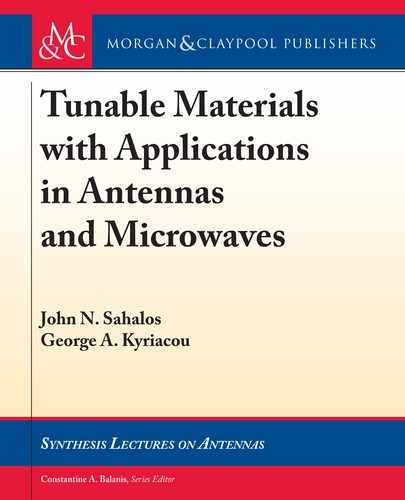
100 3. FINITE FERRITE SAMPLES
e next step in the analysis is to abandon plane-wave approximation and consider a
more accurate distribution of the dipolar magnetic field, obeying the boundary conditions on
the specimen surface. Fortunately, in this case, the wavelength is so large compared to the sample
dimensions that propagation may be ignored. In other words, we are in the area of magnetostatic
modes.
3.16 MAGNETOSTATIC WAVES
e term “magnetostatic waves” [30] refers to the low wavenumber (k ! 0) area of the spin-
wave manifold. A qualitative difference between spin and magnetostatic waves is a wavenum-
ber k
min
D 2=
max
10=.sample dimensions/. erefore, for k < k
min
or >
max
, one may
seek magnetostatic waves. In turn, magnetostatic waves could be understood in a broad sense
as being “spin waves of finite samples.” To be more specific, their wavelengths are so large that
exchange interaction is negligible. In contrast, the dominant mechanism exciting magnetostatic
waves is the dipole-dipole interaction. However, in this case, the sample dimensions are compa-
rable to the wavelength and the field generated by the surface magnetic-charge (poles) density
can effectively reach every point within the sample. us, both, volume (r
N
M ) and surface
equivalent magnetic charge densities must be taken into account. Besides this, the phase ve-
locity (V
ph
) of magnetostatic modes is very small compared to the speed of light (c) as well as
the speed of an electromagnetic wave
c=
p
"
r
r
D c=n
. In turn, for practically used samples
propagation (phase difference from point to point) can be ignored and the so-called “magne-
tostatic approximation” can be employed in their analysis. us, magnetostatic modes are shape
dependent due to surface poles (On
N
M ) but are size independent as propagation is ignored. Like
electrostatics, the field quantities (
N
H ;
N
M ) are assumed to vary synchronously in time all over
the sample. Sometimes, this definition is roughly considered. at happens because waves with
inherently assumed propagation exist. More accurate is the use of magneto-quasi-static modes.
In this case, the fields are in acceptable agreement with real-world measurements where some
propagation exists.
To sum up, we can say that in the analysis, the magnetic surface-charge density ( On
N
M )
should be taken into account ( On is the unit outward normal at the sample-air interface). In other
words, magnetostatic waves are coming from the magnetization discontinuity at the sample-air
interface. Since the magnetic-field intensity inside the specimen (internal
N
H
i
) is directly pro-
portional to magnetization, the boundary condition is assigned to the discontinuity of the mag-
netic field. e same has already been done in Section 3.4, where the discontinuity was taken
into account through the demagnetization factors [N ]. e major difference in this case is that
the volume magnetic charge is assumed to be equal to zero, or equivalently, magnetization is
homogeneous, r
N
M D 0. As the whole problem is about boundary conditions and, in particu-
lar, only shape dependent, significant research effort has been devoted to magnetostatic modes.
Walker [9, 10] studied spheroid samples and established the procedure for magnetostatic-wave
..................Content has been hidden....................
You can't read the all page of ebook, please click here login for view all page.
